Vietnamese New Year is the most important holiday in Vietnam culture. It begins to start a new year with the best, hopefully a peaceful, lucky, successful new year.
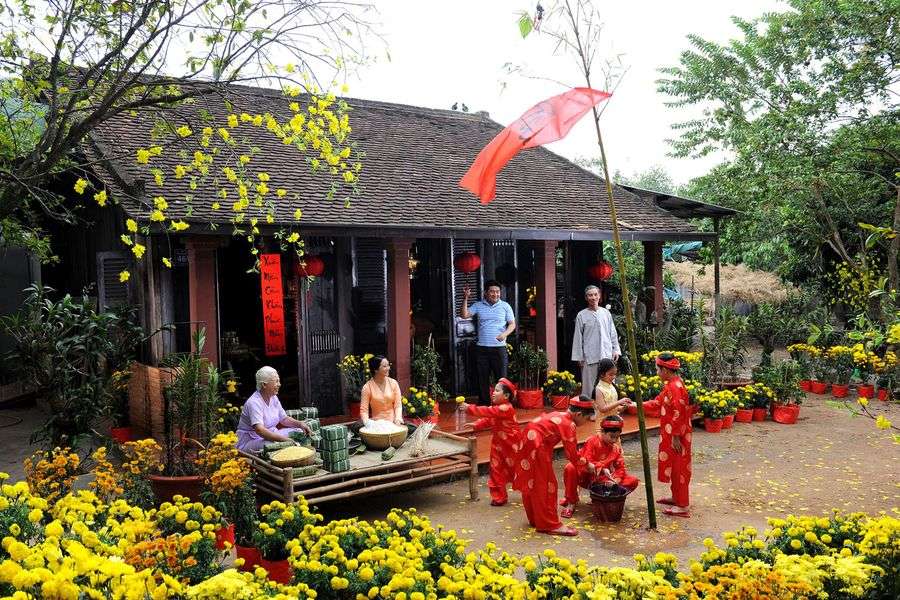
Lunar New Year is also when people come home to reunite and ask about each other after a long year away from home. This is a very important holiday for Vietnamese people, so on this traditional New Year’s day, there are customs and practices that have been passed down from ancient times to now and gradually become a beauty in Tet culture. These customs are also a substitute for a happy and peaceful new year.
Let’s join @goexplorevietnam to learn about the customs of the Vietnamese New Year.
When is Vietnamese New Year?
| Year | Date |
|---|---|
| 2021 | 12 February |
| 2022 | 1 February |
| 2023 | 22 January |
| 2024 | 10 February |
| 2025 | 29 January |
| 2026 | 17 February |
| 2027 | 6 February |
| 2028 | 26 January |
| 2029 | 13 February |
| 2030 | 2 February |
Before the New Year
Ong Cong – Ong Tao Ceremony (Kitchen Guardians’ Day)
Kitchen Guardians’ Day, or ngày Ông Táo, is held each year on December 23rd according to the lunar calendar. Typically, during this festival families will prepare a feast to worship the three kitchen guardians to assure their kitchens will be peaceful for the rest of the year.
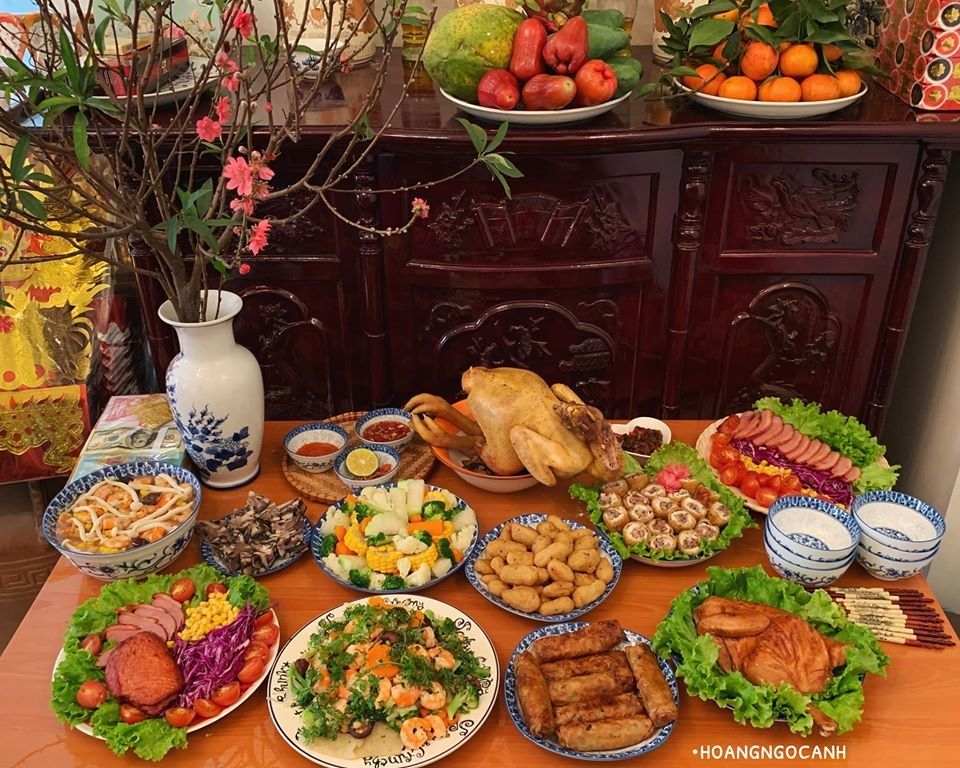
On this day, people usually clean the kitchen, make a tray of rice to worship Ong Cong – Ong Tao to see off to heaven. Items used to worship these guardians include carp, and three sets of miniature paper costumes for Kitchen Guardians, two male, one female.
Families usually begin worship before noon, burn one round of incense, then take the worship items down from the altar and burn the joss paper money, or the money for gods or those who passed away.
Three sets of kitchen guardian paper costumes with the joss paper money are burned because it is believed that this is the way to send offerings to the dead and to the Gods.
Kitchen guardians are also representative of the happiness and well-being of a family, whether a family is prosperous, happy, or not depends on family meals.
Therefore, the worship of kitchen guardians on the Vietnamese New Year is also a symbol of the peace and happiness of a family; wishing to become more harmonious and happier next year.

Some families give offerings of paper carp, but there are also some families who offer living carp. After burning the paper carp in the offering, they drop the carp into lakes and rivers nearby so that the Kitchen Guardians may freely fly to Heaven to meet the King of Heaven.
Visiting ancestors’ grave
Starting from December 23 to 30 of the lunar calendar every year, descendants of the family visit and clear ancestral graves. They often bring incense and fruit to worship and invite their ancestors to come home to celebrate Tet with their children and grandchildren.
This is a common custom of all Vietnamese people, showing piety and respect for deceased loved ones. It is also the “Never forget where you came from” tradition of the Vietnamese people.
House cleaning and decoration
On the days of Tet, Vietnamese people often have the habit of cleaning their houses, throwing away old things, buying new ones with the meaning of wishing for a new year all the bad things of the year. The old ones are removed, welcome the new, the good luck in the coming year.
On this occasion, flowers are indispensable items in every family on Tet holidays; it symbolizes the luck of Tet, the more beautiful the blooming, the more fragrant the new year becomes.

In the North, people often choose red peach branches or peach trees, kumquat trees to decorate the house with red peach blossoms symbolizing luck; and the more kumquat tree, the more fruit it shows that the family received more buds in the new year.
In the Central and the South, using yellow apricot branch because according to their conception, the golden apricot represents the magnificence of the feudal king, a symbol of development and promotion.
Although each region has a different color and flower color, it all represents luck, happiness, and prosperity for the family.
Making Banh Chung, Banh Tet
Banh Chung and Banh Tet are an indispensable part of the cultural beauty of the Vietnamese people; every year, on Tet every year from 27, 28, 29 Tet, all families gather together to pack Banh Chung.
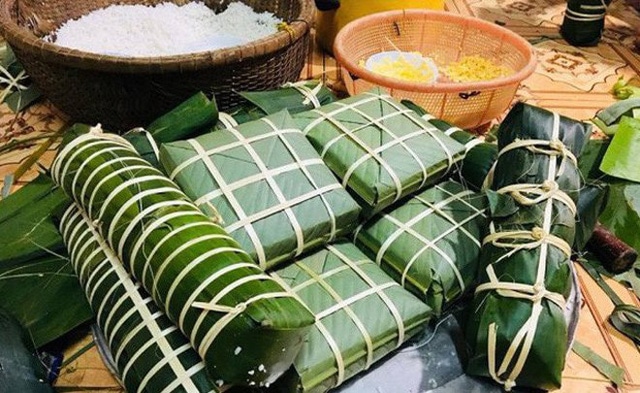
In the South, there is the Banh Tet, which is cylindrical; In the North, there is a square Banh Chung. Although the shape is different the ingredients are exactly the same, rice is the main ingredient of the cake, and represents the long-standing wet-rice culture of Vietnamese people.
This tradition dates back to the time of King Hung and up to now is an irreversible thing in the cultural beauty of Vietnamese New Year; Every family must pack for themselves a few dozen cakes to worship ancestors, give friends and relatives or eat on Tet.
The time of making Banh Chung is the time to remember their roots; people have more time to gather together, tell stories about an old year that has passed, and hope for a square new year. The rounder the Banh Tet, the more square the Banh Chung, the more complete, prosperous, and successful the new year.
Build a New Year Tree
Legend has it that every year, the devil comes to destroy the mob every year; so in order to dispel evil and bad luck, every place will build a tree to signal that the place has an owner, the devil is not to be harassed.
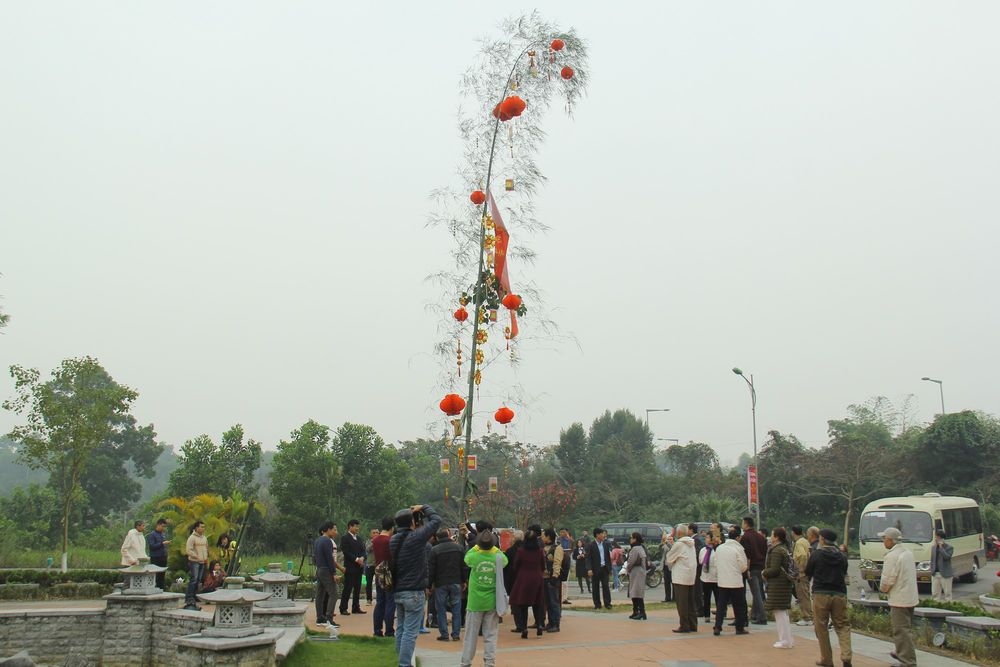
The New Year tree is a bamboo tree about 5 to 6 meters high. At the top of the tree, many things are hung with gold and silver paper, a charm to kill the evil, and a gourd of wine braided with straw; Besides, there is a small lantern, which is both meant to dispel evil, unlucky things, and to light up the light for ancestors to know the way home to celebrate Tet with their children. The tree will be planted from December 23 through January 7 when it will be lowered.
TET market
Unlike normal day markets, Tet markets are always more crowded and busier. People go to Tet market not only to buy essential items on Tet holiday but also to meet each other, chat, enjoy the atmosphere of Tet bordering on Tet.
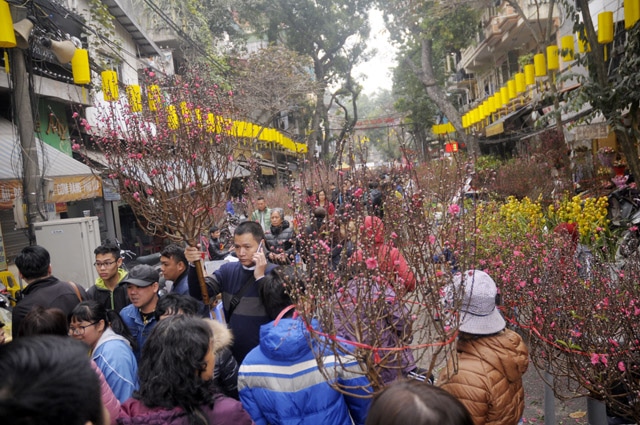
Tet market is usually held on a large lot of land, where all necessary items are sold; adults buy Tet products, children are also followed by their mothers to buy new clothes from their mothers. Everyone is holding a heavy basket.
Fruit tray presentation
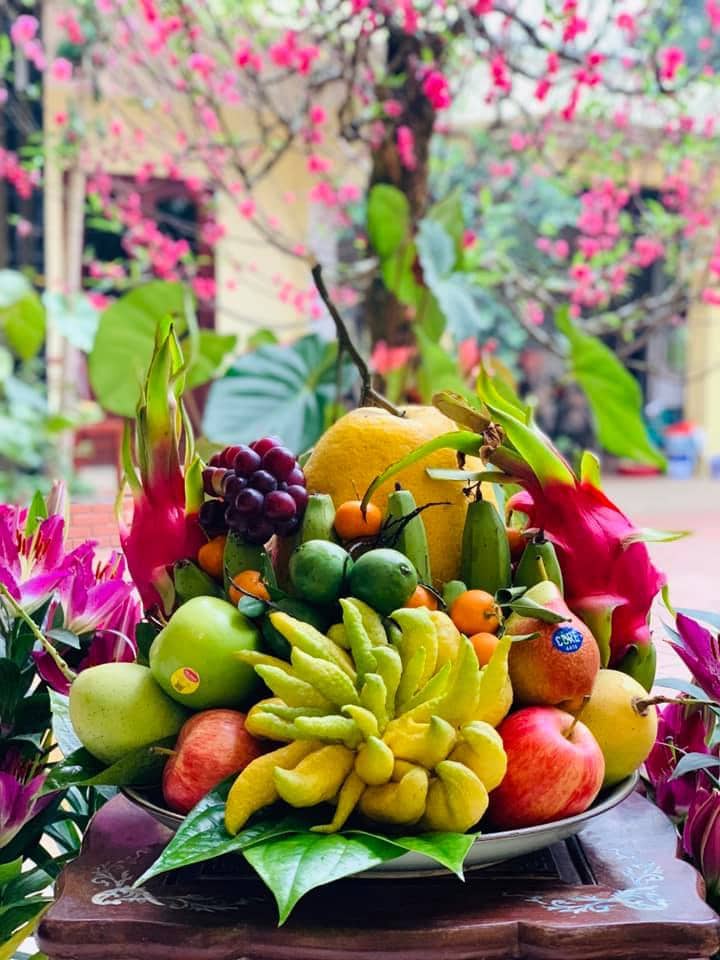
The five- fruits tray is an indispensable item on the ancestor altar during the Vietnamese New Year; Depending on the region, there are different fruits with different characteristics; but the ancestor altar is always full of five fruits to wish for a new year of peace, luck, happiness, safe, rich and precious; hope that a new year will be full and more prosperous.
Ancestor worshiping ceremony
According to Vietnamese customs, in every family there is an altar of ancestors and grandparents; Depending on the family, there are different decorations and arrangements.
At the end of the year, each family cleans the altar to prepare for Tet; then on the afternoon of December 30, food and fruit are arranged on the altar to present to the ancestors to expect ancestors to return home to celebrate Tet with family.

This is also the act of demonstrating the humanistic, ethical and lifestyle values of the Vietnamese people, reminding children and grandchildren to keep their family’s morality, the lifestyle of “drinking water, remember its source”, not forgetting the origin
The beginning of the new year
New Year’s Eve

This is the transition time between the old year and the new year, a sacred time of heaven and earth harmony. Celebrating New Year’s Eve takes place at the last moment of the old year; so the activity also has the meaning of getting rid of all the bad things of the old year, to welcome the good things of the new year. New Year’s Eve rituals must be performed outdoors.
Pick buds in early spring
At the right time of New Year’s Eve or early the next morning, Vietnamese people often have the habit of picking buds at the beginning of the year; with the desire to bring the fortune-telling to home to welcome a lucky new year.
To first foot on new year “xông đất”
The moment New Year’s Eve ends, entering a new year, homeowners often choose the first person to enter their house to “xông đất”; It must be the people who are at the right age with the owner, gentle, a happy family, doing a thriving business with the desire for a favorable and good new year.
First departure of new year
On January 1, people often choose the direction, time and means to leave the house; with the expectation that when the new year turns into a new year, all will be good, the whole year has good things, no bad things.
Happy New Year and New Year lucky money
This cultural feature dates back to ancient times, and wishes Tet not only a tradition but also a cultural beauty on Tet. On the first of January of the year, everyone in the family often goes together to celebrate New Year on both sides of the paternal – maternal family, bringing gifts to celebrate for the owner.
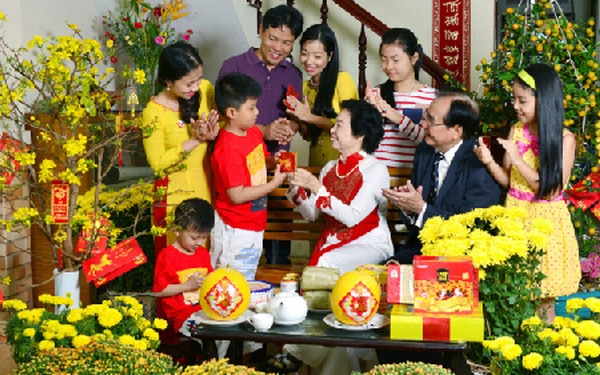
Children and grandchildren wish their grandparents and the elderly to the new year good health, luck and peace; then be wished by the adults together with a small red, rectangular red envelope; New coins inside are meant to wish your children and grandchildren will gain more luck and success more and more.
Money in the lucky money is not more or less important, but it is in the meaning and culture; it represents the fortune, the luck of both the giver and the receiver.
Visit the pagoda/temple in the new year
Going to pagodas at the beginning of the year is one of the cultural beauty of Vietnamese people. At the beginning of the year, people often go to the pagoda/temple with the desire to pray for a lucky, happy new year; at the same time, it is also a job to show their respect to the Buddha, the ancestors.
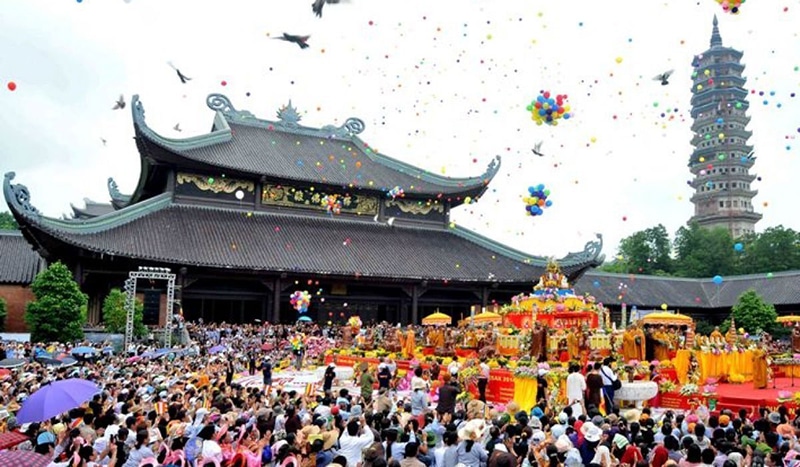
Going to the pagoda at the beginning of the year is also about making yourself purer; washing old things, starting a new year with good luck and good things.
Ask for calligraphy in the new year
In earlier days, most working-class members were illiterate. So they often asked local scholars to write one or two letters to hang inside the house; hoping that their children would be better educated. Later, especially before Tet holiday, people usually asked for letters simply as a sign of good luck. Nowadays, asking for letters is more and more popular; it has become a beauty in the Vietnamese cultural tradition every Tet to spring.
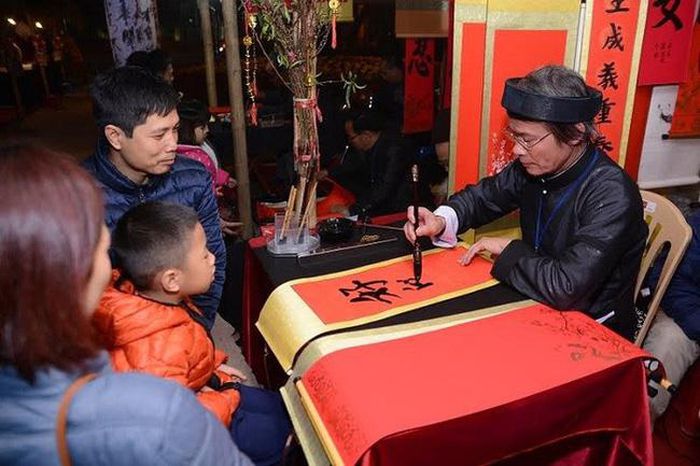
Vietnamese New Year is the beginning of a new year, so everyone hopes they will achieve good luck in the coming year; so Tet customs seem to have taken root in Vietnamese life; becoming an indispensable part, a habit in Vietnamese culture.
It is also a good tradition that everyone needs to cherish and follow.
Meaningful New Year wishes on the Vietnamese New Year
The traditional greetings are “Chúc Mừng Năm Mới” (Happy New Year) and “Cung Chúc Tân Xuân” (gracious wishes of the new spring). People also wish each other prosperity and luck. Common wishes for Tết include:
Sống lâu trăm tuổi (long life of 100 years): used by children for elders. Traditionally, everyone is one year older on Tet, so children would wish their grandparents health and longevity.
An khang thịnh vượng (security, good health, and prosperity)
Vạn sự như ý (may myriad things go according to your will)
Sức khỏe dồi dào (Plenty of health)
Cung hỉ phát tài (congratulations and be prosperous)
Tiền vào như nước (many money flows in like water): used informally
Vietnamese New Year FAQs
Tet in Vietnam and China has many differences because each country has its own unique culture.
Yes. Because this is a fine cultural custom of the Vietnamese people and many countries in the region, wishing for the best and get good luck from the first days of the new year.
Cash lucky money is not only limited to the first day of the new year, but it can be redeemed during the first three days of the year, even lasting until the last days of Tet such as the 9th and 10th.
– Do not go to other people’s homes on the 1st if you are not invited.
– Don’t say unlucky things.
– Do not borrow money from others.
– Don’t break things.
– Do not give or ask for fire (fire is conceptually a symbol of luck. Therefore, at the beginning of the new year, if you go for fire, you give your luck to others).
…


4 thoughts on “Vietnamese New Year – Learn about the traditions and customs of the Tet Holiday”